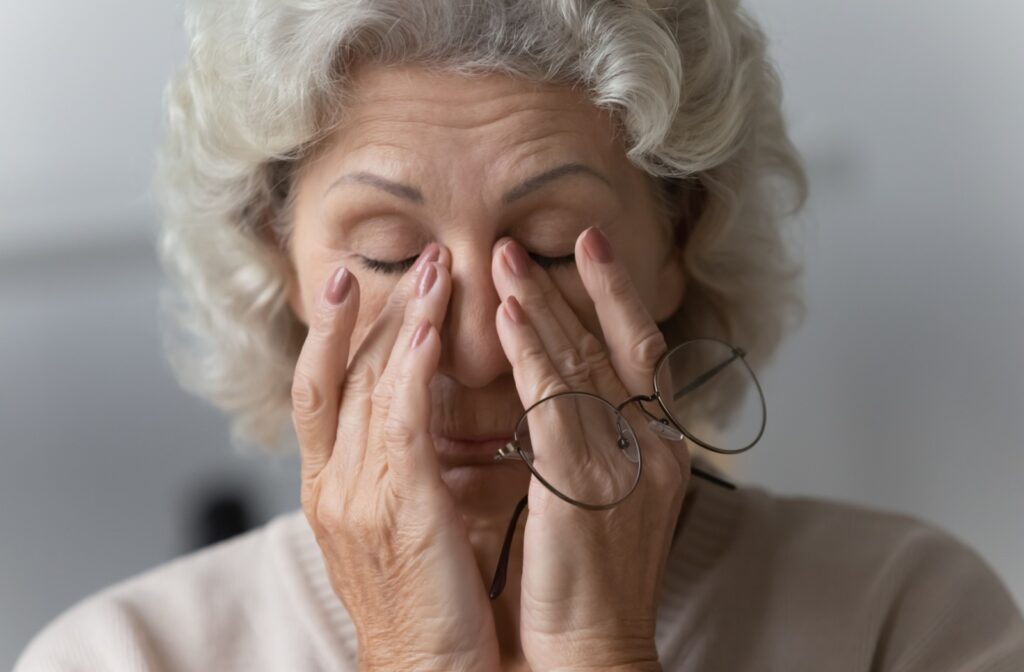When your eyes don’t produce enough tears or your tears evaporate too quickly, the eye’s delicate tissues can become dry and irritated. This feeling might be caused by dry eye, an eye condition affecting as many as 30% of Canadians.
Most of the time, dry eye will cause symptoms such as burning, redness, and stinging in the eye, and can be treated by your optometrist. However, in the most extreme cases, dry eye can damage your corneas, which could lead to blindness. Luckily, you can stay on top of your dry eye by scheduling regular eye exams and following dry eye treatments recommended by your optometrist.
What Causes Dry Eye?
Your eyes use tears to lubricate the surface of your eye and keep it protected. These tears are created in the tear ducts and are mixed with special oils created in your eyelids. Ocular surface disease, also called dry eye, happens when your eyes can’t produce enough high-quality tears.
When your eyes don’t have enough tears or poor-quality tears, it can cause the surface of your eyes to dry out. When the surface of the eye becomes dry, your eye is exposed to bacteria and particles in the air, which can lead to eye irritation.
Some common causes of dry eye include:
- Environments, where the air is either dry, smoky, or windy, can cause dry eye.
- Dry eye can be a side effect of certain medications including antihistamines, antidepressants, and birth control medications.
- Seniors are much more likely to develop dry eye than young and middle-aged adults.
- Wearing contacts can increase your risk of dry eye.
- Using screens for long periods may cause you to blink less, which can cause dry eyes.
If you consistently experience dry eye symptoms, it is important to consult your optometrist. Your optometrist can help you find a dry eye treatment that works for you.
If left untreated, the inflammation caused by dry eye can lead to corneal abrasion. This means the cornea (the surface of your eye) becomes scratched and damaged. This damage can lead to complications like corneal ulcers, and even vision loss if dry eye is left untreated.
Signs of Dry Eye
Dry eye doesn’t look the same for everyone. The symptoms of dry eye may vary depending on the person. Common symptoms of dry eye include:
- Itchy eyes
- Burning eyes
- Red eyes
- Feeling like something is stuck in the eye
- Light sensitivity
- Watery eyes
- Blurred vision
- Eye fatigue
While dry eye seldom leads to permanent eye damage, it can be incredibly uncomfortable. If you start to notice any of the signs of dry eye it is a good idea to consult your optometrist. This can be done during a regular eye exam, or in a tele-optometry appointment if your eye care provider provides telehealth services.
Managing Dry Eye
Dry eye can be caused by medical factors and environmental factors. This means that managing your dry eye may involve medical interventions, and making slight adjustments to your home and work space.
Environmental Changes
Since dry eye can be caused by dry air, it may be a good idea to invest in a humidifier if you live in a dry climate. In addition, contacts may put you at a higher risk of developing dry eye. If you begin using contacts and find yourself experiencing dry eye symptoms, you can switch to glasses to cut down on the amount of time you have to wear contacts.
Dry eye can also be caused by spending a long time looking at screens. If you can, reduce the time you spend looking at a screen. Make sure to take frequent breaks, and follow the 20-20-20 rule. Every 20 minutes, take a 20-second break to stare at an item 20 feet away from you. This will encourage you to blink more frequently, and help you avoid digital eye strain.
Dry Eye Treatments
When dry eye is caused by factors out of your control, such as aging, medications, or dysfunctional tear ducts you may need a medical intervention. Several medical interventions for dry eye include:
- Prescription eye drops like RESTASIS, Cequa or Xiidra.
- Warm eye compresses and eyelid cleaning procedures.
- Punctal plugs.
- IPL (intense pulsed light) and/or RF (radiofrequency treatment).
Find the Dry Eye Solution For You
While untreated dry eye can lead to serious damage to your eyes, there are ways to avoid potential vision loss. By keeping up with regular eye exams, your optometrist can monitor your dry eye symptoms and help you find a treatment plan. The Canadian Association of Optometrists recommends that adults have a comprehensive eye exam at least once every two years.
At Willoughby Doctors of Optometry, we offer a variety of dry eye treatments so we can create a treatment plan personalized to you and your lifestyle. Whether you need help with dry eye, or it’s just time for a comprehensive eye exam, our friendly staff is here to help you.
Book an appointment with us today, and take the first step to meeting your eye care needs.











